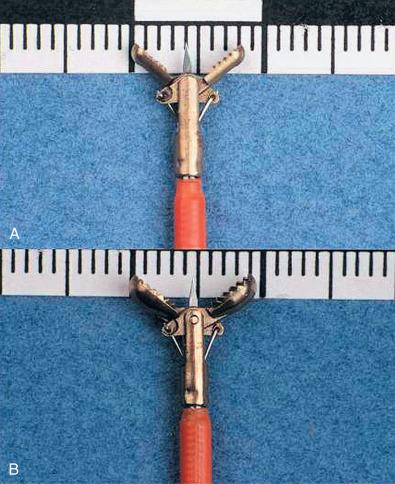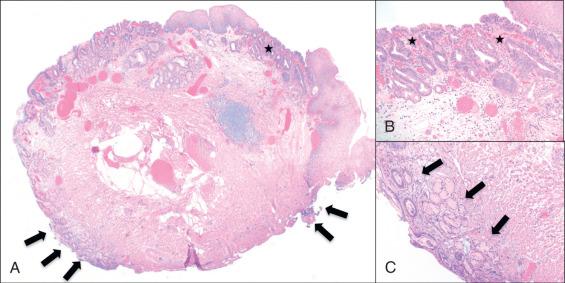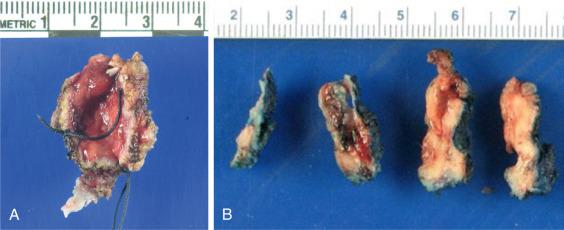Physical Address
304 North Cardinal St.
Dorchester Center, MA 02124
The most common pinch biopsy forceps used worldwide fits through a 2.8-mm biopsy channel ( Fig. 5.1 ). In general, mucosal samples vary from 4 to 8 mm in size. A smaller-sized forcep that fits through a 2.2 mm biopsy channel is used in infants and young children. Pediatric gastroenterologists generally use narrow-bore instruments for routine diagnostic biopsies if the child weighs less than 10 kg. The primary aim of a pinch biopsy is to obtain a specimen sample that contains full-thickness mucosa, including muscularis mucosa. The tissue yield of endoscopic biopsies relies on the forceps size, amount of pressure applied on the forceps while placed against the mucosa during the biopsy procedure, and the optimal angle of the forceps when applied to the mucosal surface. In the gastric body, where mucosal folds are thick, or in conditions associated with mucosal thickening, full-thickness mucosal sampling may not be achieved using a 2.8 mm channel biopsy. The inability to sample full-thickness mucosa may influence the amount of diagnostic information obtained from histologic examination.

The large-cup (“jumbo” or “max capacity”) forceps requires a large channel (also termed therapeutic ) endoscope (biopsy channel; 3.6 to 3.7 mm). Some newer designs are intended to provide larger biopsy specimens with the conventional 2.8-mm channels and intermediate-sized channels such as pediatric colonoscopes. Larger capacity forceps biopsies increase the diagnostic yield upon histologic examination. Specimens obtained with a jumbo forceps often exceed 6 mm in maximum diameter, but these are not necessarily deeper than standard biopsies. Rather, a jumbo forceps typically provides more mucosa for analysis. This is particularly useful during surveillance tissue sampling, such as in patients with Barrett's esophagus (BE) or ulcerative colitis. Another advantage of large capacity forceps biopsies is that larger tissue fragments enable histotechnologists to better orient the sample during tissue processing. Jumbo biopsy forceps are as safe as standard biopsy forceps, although the need to use a larger diameter channel may be less comfortable for patients.
Biopsy specimens obtained with small or larger capacity pinch forceps usually contain very little submucosa, if any. It is sometimes difficult to obtain specimens with sufficient submucosa, such as during a biopsy for a submucosal lesion or when the objective is to diagnose amyloid or other disorders that manifest predominantly in the submucosa. Ancillary techniques, such as fine-needle aspiration or needle core biopsy, may increase the diagnostic yield of submucosal tissue.
Hot biopsy forceps are insulated pinch biopsy forceps through which electrical current is passed, after which the remaining tissue is ablated in situ using electrocautery. Unfortunately, the result is cautery artifact in the sampled tissue, which, in small tissue samples, often makes histologic interpretation difficult (or impossible). In addition, the electrocautery technique carries an excessive risk of perforation from deep tissue burn, particularly in the cecum and ascending colon. Finally, residual dysplastic tissue on follow-up after hot forceps biopsy has been reported in 10.8% to 17% of patients post hot forceps biopsy. For these reasons, hot biopsies have been largely abandoned by most endoscopists.
Snare biopsy is an endoscopic technique during which a wire is placed around a polypoid lesion that protrudes into the lumen, and this allows for removal of the lesion. Snare biopsy is used primarily for colonic polyps, but polyps anywhere in the gastrointestinal (GI) tract may be removed using this technique. Snares are available in a variety of sizes and can be used in conjunction with electrocautery. Depending on their size, excised polyps are either retrieved through the suction channel of the endoscope or held by the snare after resection while the colonoscope is removed from the patient. The snare biopsy can be used to remove pedunculated or sessile polyps of various sizes. Snare biopsy is the recommended method over pinch forceps biopsy for removal of diminutive (less than 0.5 cm) and small polyps (0.5 to 2 cm). Several randomized studies have shown a higher rate of complete resection of adenomatous polyps using cold snare biopsy compared to cold forceps biopsy. Pedunculated polyps are generally easily removed using snare biopsy, and the main risk of this procedure is post-polypectomy bleeding from vessels located within the stalk of the polyp. In the case of larger polyps, piecemeal removal may be employed. However, piecemeal polyp removal may limit the ability of pathologists to assess the margins of resection. Sessile polyps, or complex polyps greater than 2 cm in size, are best referred to experienced endoscopy centers for removal.
During hot snare polypectomy, the endoscopist is able to apply modulated electrosurgical current to a metal wire that cuts through pedunculated polyps at the base of the lesion. This assists tissue removal and coagulation of vessels at the base of the polyp or within the polyp stalk. Use of electrocautery versus cold snare polypectomy must be balanced against the risks of perforation and post-polypectomy bleeding. Electrocautery artifact also persists in the biopsy sample during tissue processing and is characterized by loss of nuclear and cytoplasmic detail ( Fig. 5.2 ). Noting this effect during histologic examination can be advantageous in certain situations, such as assessment of the cauterized margin of resection. However, too much electrocautery artifact can also preclude assessment and classification of polyps, especially if the artifact is present throughout the tissue submitted for histologic examination. In general, the risk of perforation following polypectomy is minimal, and is greatest in portions of the colon covered by free serosa. Cold polypectomy, without electrical current, avoids use of cautery, thereby limiting the amount of burn artifact in the specimen and thus minimizing the risk of perforation.

Endoscopic mucosal resection (EMR) is an advanced endoscopic technique used for removal of premalignant or malignant lesions that are mainly confined to the mucosa, or in some cases superficial submucosa. One principle method of EMR is the use of a liquid cushion to expand the submucosa and minimize transmural cautery damage. Using this technique, the specimen usually includes mucosal and submucosal tissue. In general, EMR requires some measure of confidence that a lesion is, in fact, confined to the mucosa or submucosa. Many endoscopists rely on endoscopic ultrasonography (EUS) to determine the depth of a particular lesion before choosing to perform an EMR procedure. The accuracy of high-frequency EUS (15 or 20 MHz) may be as great as 95% for determining whether a lesion is limited to the mucosa.
Several variations of the EMR technique are currently used. Many rely on submucosal injection of liquid, most often saline. Less commonly, diluted epinephrine is used in addition to saline, which helps constrict small blood vessels at the base of the lesion. Other techniques advocate hypertonic solutions of 3.5% saline or 50% dextrose or sodium hyaluronate. The quantity of liquid injected also varies; the idea is that the injected lesion should appear to be raised by a cushion of liquid above the mucosal surface before resection is attempted. Failure to “lift” the lesion despite generous use of submucosal saline (the so-called nonlifting sign) may be an indication that a lesion has spread deeper into the bowel wall.
Two major types of EMR techniques are used: the lift and cut technique (also known as strip biopsy), without the use of suction, and aspiration mucosectomy, which employs suction as part of the method. Both methods typically also feature a snare that is used around the lifted lesion. Aspiration mucosectomy, in particular, has been widely successful for removing lesions in the GI tract. A newer EMR technique is similar to aspiration mucosectomy, but after the lesion has been suctioned into the cap, a small rubber ring is released around the base of the lesion, similar to the method used during endoscopic variceal ligation. Once suction is released, the lesion appears contained within a “pseudopolyp” that may be removed by snare cautery. This is known as band-ligation EMR.
Endoscopists and the pathologists who handle EMR specimens must recognize that these samples may contain cancer; therefore they should be handled appropriately and oriented correctly for optimal pathologic tumor staging, including assessment of depth of invasion, and the margins of resection, including assessment of the deep submucosal margin ( Fig. 5.3 ). EMR allows the endoscopist to attempt an en bloc resection and thus, potentially, to completely resect an early malignant lesion. En bloc resection is limited, however, to lesions no more than 1.5 to 2 cm in largest diameter. If deep margins are positive for neoplasia, surgical resection of the affected region is advocated. Current indications for EMR include superficial carcinoma of the esophagus or stomach in patients who are not candidates for surgery; unifocal high-grade (or low-grade) dysplasia in BE; and large, flat colorectal adenomas (which might otherwise require piecemeal resection) regardless of the degree of dysplasia. EMR as a form of primary therapy for small, superficial cancer has gained increasing popularity in the United States but is even more widely used in Japan, where early gastric cancer is more common. EMR is also used as a form of primary therapy for small submucosal lesions, such as rectal carcinoid tumors or leiomyomas. In many cases, the submucosal lesion can be completely resected.

Brush cytology is a method used for broad sampling of the mucosal surface. Cytology brushes share common design features: bristles, usually composed of nylon or metal fibers, branch off a thin metal shaft that runs lengthwise within a protective plastic sheath. The various brushes that are currently available do not seem to vary in terms of performance characteristics. The cytology brush is passed through an accessory channel of an endoscope. The end of the sheath is passed out of the tip of the endoscope, and the bristle portion of the brush is then extended from the sheath. The brush is rubbed back and forth several times along the surface of the mucosa, lesion, or stricture, and is then pulled back into the sheath. The sheath is withdrawn from the endoscope, and the brush is pushed out of the sheath, thus exposing the bristles. The bristle portion of the brush may be cut off, placed into fixative, and sent in its entirety to the cytopathology laboratory. Alternatively, the bristles may be rolled against a glass slide in the endoscopy suite. The slides should be immediately sprayed with fixative or submerged within it and subsequently delivered to the cytopathologist. If smears are made in the endoscopy suite, little additional benefit is derived from inclusion of the bristles for cytopathologic analysis.
Brush cytology is often used in the pancreaticobiliary tree in order to sample strictures in the pancreaticobiliary tract, or in the esophagus to sample esophageal plaques or lesions suspicious of infectious esophagitis. Of the three major potential infections of the esophagus, Candida albicans and herpesvirus are characterized by having organisms in surface exudate and surface epithelial slough. In contrast, cytomegalovirus is typically present deeper in the tissue stroma and is not commonly detected in cytologic smears of exudate. Smears of exudates for cytologic examination for herpesvirus or Candida may provide a rapid diagnosis. Brushings may also be used for viral culture or polymerase chain reaction (PCR) for herpesvirus, if clinically indicated. For viral culture, the use of a culture medium is needed; a second brushing may be swirled around in a culture medium, or the brush tip may be cut off with wire cutters and left in the bottom of the culture medium container.
Cytologic brushings of biliary strictures are an important tool in the assessment of strictures within the pancreaticobiliary tree. Endoscopic biopsy in this location is problematic, largely due to the inability to access and visualize lesions adequately to be sampled. Cancer detection rates with brush cytology sampling rates are disappointing. Combining brush cytology with ancillary techniques, such as fluorescence in situ hybridization, improves accuracy and diagnostic yield.
Brush cytology has been proposed as an alternative method of surveillance in patients with BE and offers the advantages of an inexpensive method and potential for sampling over a greater area of the esophagus. In a prospective study by Kumaravel et al (2010), 530 patients were assessed using paired cytologic brushings and histologic biopsies. A concordance rate of 80% between the two methods was documented. Cytology excelled at detection of high-grade dysplasia (HGD) and adenocarcinoma, but it had poor sensitivity for detection of low-grade dysplasia (LGD). Brush cytology has also previously been used in combination with fluorescence in situ hybridization for detection of DNA abnormalities in a large cohort of BE patients. In another study by Timmer et al (2014), DNA gains detected in brush cytology samples of BE patients may predict a lower response rate to endoscopic therapy.
Become a Clinical Tree membership for Full access and enjoy Unlimited articles
If you are a member. Log in here